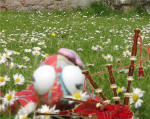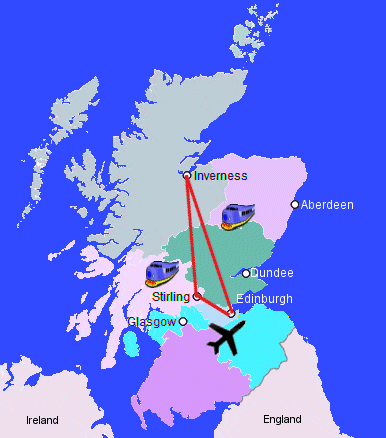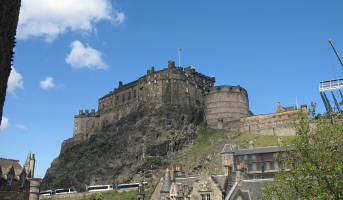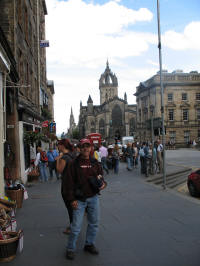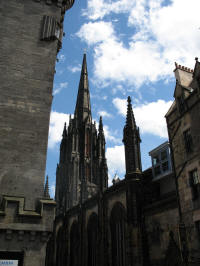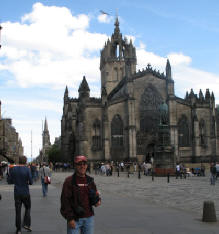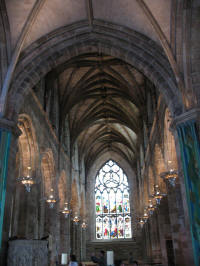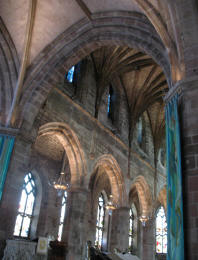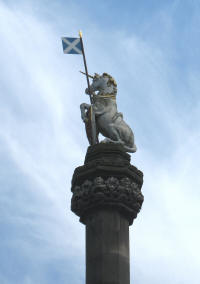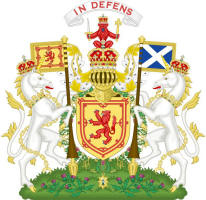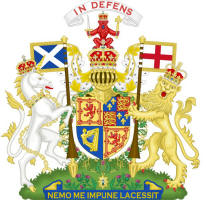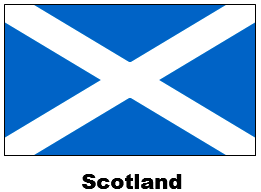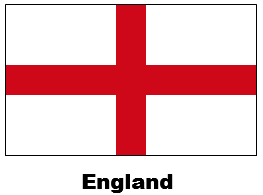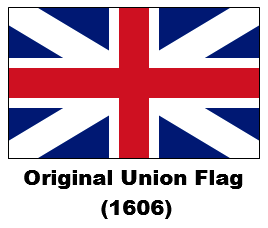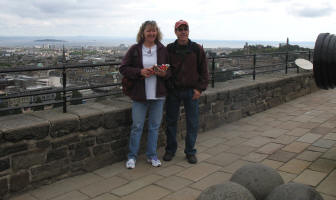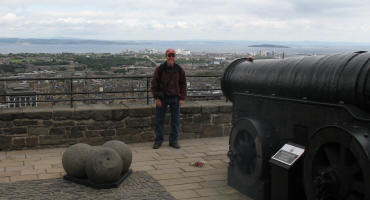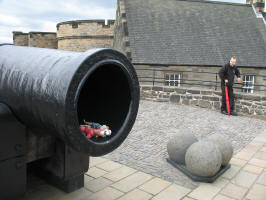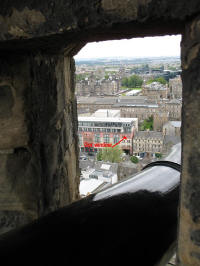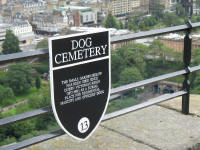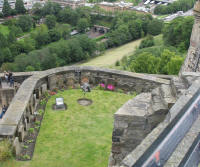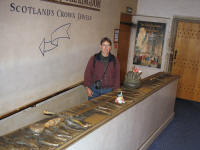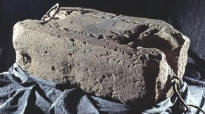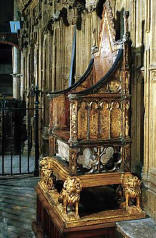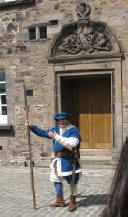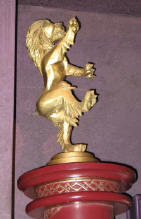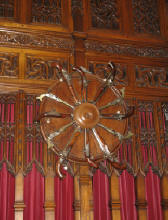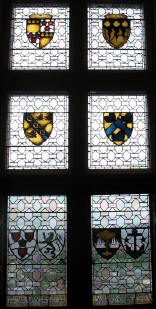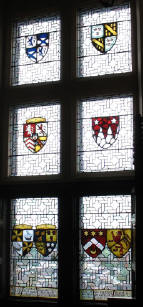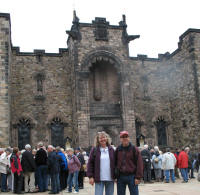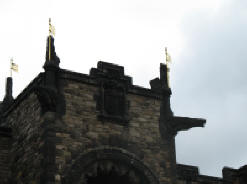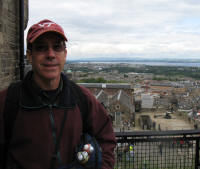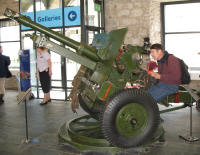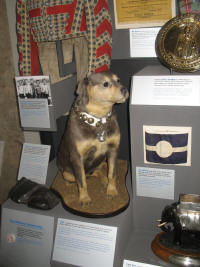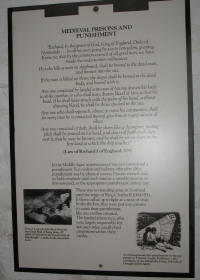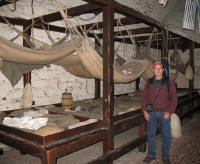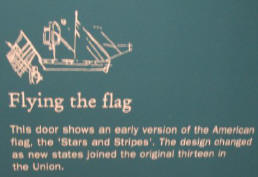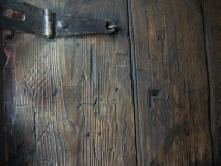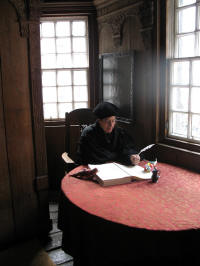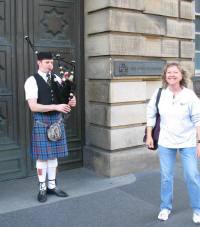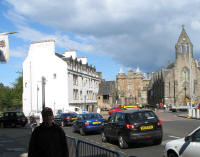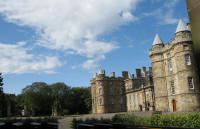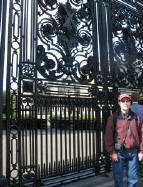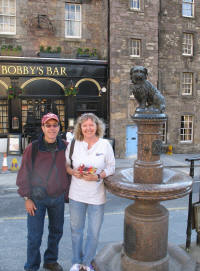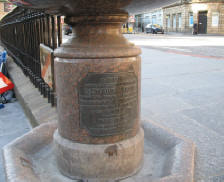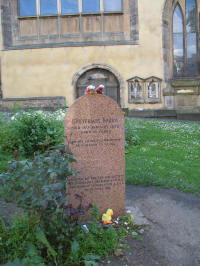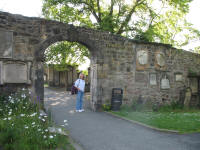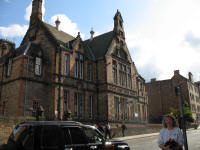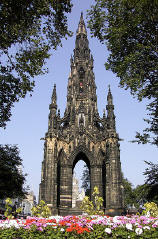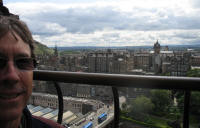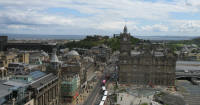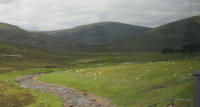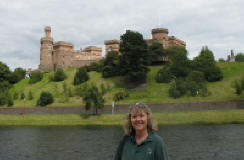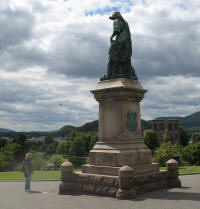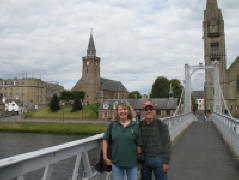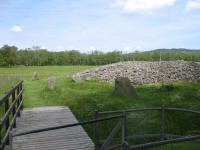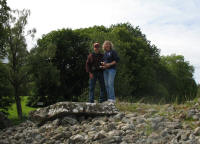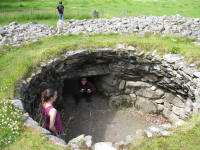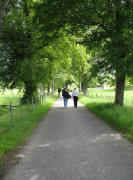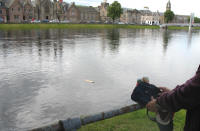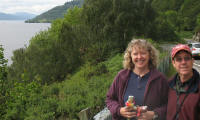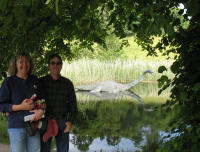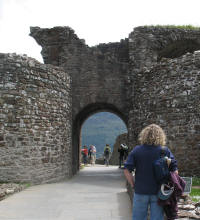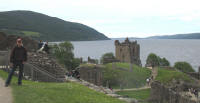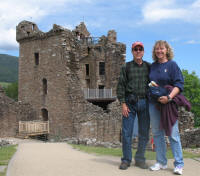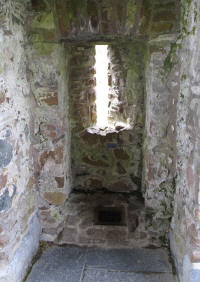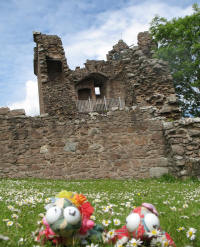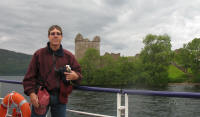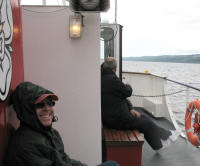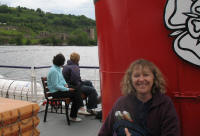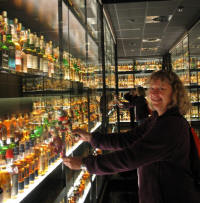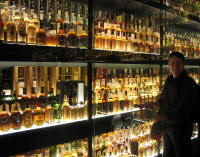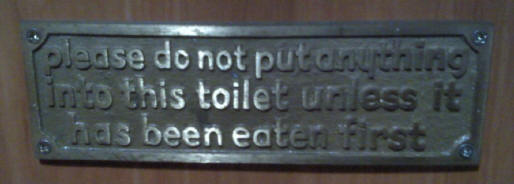|
When we arrived in Stirling we made the
short walk to our hotel, the
Barcelo Stirling Highland. Leave it to Bob to still have some
surprises up his sleeve - in 1854 it was a high school.
The green dome on the top is a working
observatory with a huge and beautiful wooden telescope. We got to go up to
look at it, but sadly did not get a picture.
|
 |
We walked around and just got a calm and slow look at the town. We got
oriented for very early launch in the morning. |
|
|
|
|
|
 top
top
 |
|
|
|
|
|
Day 2 in Stirling -
The Fourth of July |
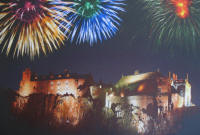 |
In our hotel room, we were greeted by a
large picture of Stirling Castle with fireworks going off in the night
sky. How fitting for to celebrate the 4th of July! |
|
|
|
|
|
Early in the morning, we were off to
Stirling Castle. The day was beautiful and the temperatures were
delightful (although we did carry our sweaters just in case).
Amy and K&K are walking up to the
castle. Only one tour bus had arrived, so we had the entire grounds to
ourselves. In the background, in sort of a golden color, is the Great
Hall. It opened to the public in the spring of 2011and is amazing
(although the color on the outside is a bit bright). |
 |
|
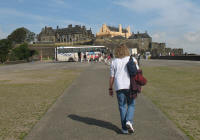 |
Bob is standing in front of the
double wall that leads to the entrance. Rather than putting in a mote
(there would have been no way to get water to it), castles like these had
a gap between walls that gave the advantage of protection to the castle's
army.
|
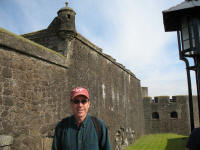 |
|
Although very few of the original
buildings remain, they date to the early 1100's. The castle was added onto
and fortified until the mid 1700's. Despite its strategic location, it
underwent numerous attacks. Here is a small list of its history and the
warring going on at the time:
Ref.
-
1296 –
captured by Edward I of England
-
1297 –
retaken by the Scots after Battle of Stirling Bridge
-
1298 –
captured by the English again after the defeat of the Scots at Falkirk
-
1299 –
surrendered to the Scots by the Constable John Samson
-
1304 – the
only significant stronghold left in Scots control, it was besieged by
Edward I. After the Scots surrendered he made them stay inside so he
could use his favourite weapon against them – a stone-throwing
trebuchet called The War Wolf
-
1314 –
retaken by the Scots after Edward II was defeated at Bannockburn
-
1336 –
retaken by the English
-
1342 –
finally returns to Scots
|
|
 |
 |
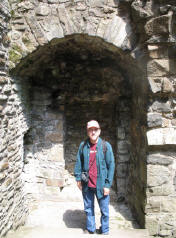 |
One of the kings that built many of the
buildings decided to decorate the outside walls with gargoyles, statues,
and power symbols to help show his people his right to rule. Bob is
standing under the oldest arch in the castle.
Mary Queen of Scots was crowned here and
multiple, horrible Scottish sieges took place on and around its walls. |
 |
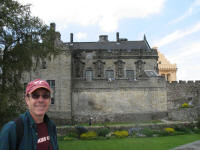 |
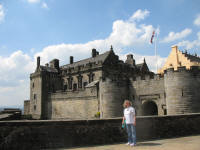 |
|
~ ~ ~ ~ ~ ~ ~ ~ ~ ~ ~ ~ ~ ~
~ ~ ~ ~ ~ ~ ~ ~ ~ ~ ~ ~ ~ ~ ~ ~ ~ ~ ~ |
 |
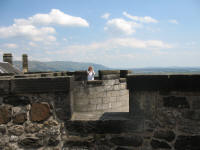
|
These two pictures are
of "dueling cameras" across the circular battlements on the walls. Amy's
picture was taken with her cell phone. (Yes, she now has a cell phone even
if she doesn't know her phone number.) |
The interior of the castle was just as magnificent. We met four
individuals who told us of life their life in the castle.
The first was Janet, the chambermaid to Mary of Guise (Mary Queen of
Scots' mother). She was fascinating! We had the entire room to ourselves
as she told us stories in accentuated with speech patterns of the time.
(Janet, if you read this, please forgive any mis-rememberings, and send a
note through time with corrections and additions from any of you all - our
email is at the bottom of this page!)
|
|
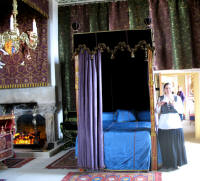 |
As she stood beside the
Queen's bed, she explained that the the bed was very short (and it was -
your feet would have stretched out over the edge.) This, she said, was
because the royals and rich believed that there were mysterious vapors
that occurred at night - especially if one laid down full flat. These
"vapors" were thought to be harmful. So to make sure they weren't brought
into one's body, they would sleep sitting up (no need for a long bed!)
Then she made the sound the vapors would have been like ... and it sounded
like snoring! :) Excellent! |
|
As we talked some more, we found out
that she would have slept on the floor in the room. She and the other
people who served the Queen were on call 24 hours a day at "her mistress's
pleasure". Yearly, she was paid the equivalent of one pound (about $1.50
today) and received a new set of clothes. But it was a job - a good
job - in a time when many were unemployed.
Their clothing was fascinating! Her
bodice told much about her station in life. Because it laced up the front,
it immediately indicated that she could not afford a "lady in waiting" -
i.e. a person to wait on her. Anyone with that kind of money would have
finer fabrics and some one to lace them into the dress/bodice in the back.
The sleeves were detachable and tied with ribbon to the shoulders and in
back to be put on in an instant. |
 |
|
~ ~ ~ ~ ~ ~ ~ ~ ~ ~ ~ ~ ~ ~
~ ~ ~ ~ ~ ~ ~ ~ ~ ~ ~ ~ ~ ~ ~ ~ ~ ~ ~ |
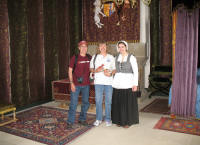 |
 |
The King
and Queen had separate bed chambers, equally rich in decoration and
tapestries. Kini and Kimi got up on the small table in front of the fire
place to have their picture taken. |
|
In the photo above with their backs
turned is another chambermaid with Janet. She told us about how the
laundry was done. OMG! They would collect urine (even royal urine) and put
it in barrels for three weeks before adding the cloth to be cleaned and
bleached. In various stages and over days and weeks, plants were burned
for their ash (potash), lye from animal fat, and human/animal urine were
combined at different stages and in particular orders to do the wash. As
she said, a particularly distasteful job. Cloth and garments were then
thoroughly rinsed, spread out on sweet smelling grasses to dry and
occasionally sprinkled with more of these mixtures to get out heavy
stains.
The sprinkling jar (which we do not
have a picture of - the story was to engaging to remember the camera), was
made of pottery and had the shape of a medium sized bell, with a large
handle on the side and solid bottom that had holes poked into it. At the
top, there was a single small hole that your thumb could cover entirely.
Very cool science here!
You submerge the jar in the liquid and cover the hole in the top with your
thumb. When you pull it out, the liquid stays inside until you take your
thumb off the top! The fabrics were then folded and
little satchels of fragrant lemon balm, lavender, and other fragrant
plants were tucked inside.
~ ~ ~ ~ ~ ~ ~ ~ ~ ~ ~ ~ ~ ~
~ ~ ~ ~ ~ ~ ~ ~ ~ ~ ~ ~ ~ ~ ~ ~ ~ ~ ~
|
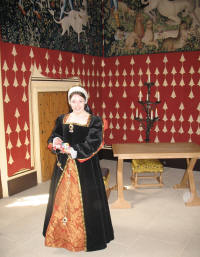 |
In the
next room we met the Queen's Lady-in-Waiting. Notice her clothing - regal,
laced in the back, with beautiful jewelry and accessories.
Kini & Kimi were entranced with her
pomander locket. It is an open, filigreed locket that holds sweet smelling
herbs, flowers and perfumes and hangs on a long chain.
Ladies would hold it to their nose
when unpleasant odors were encountered in their walks and travels. |
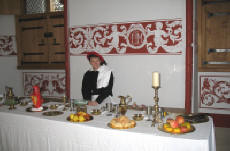
K&K got on the table
to view the lovely
foods that
were served to the royals. |
Banquets and entertaining at the
King's/Queen's table was spectacular. The best meats, fruits, wines, and
delectables graced the royal tables. They chose what they wanted. The
platters were then offered to the highest ranking guests. From there they
went to people of lesser importance, and on it went do the bottom of the
lists.
During feasts and festivals that included the general populace, only the
basic food fair survived to be served. Although they did not know it at
the time, these people were not getting the nutrients necessary to keep
them healthy - although their bellies were probably full. Sickness of the
general masses was in large part due to this "food chain" practiced at the
time. |
|
~ ~ ~ ~ ~ ~ ~ ~ ~ ~ ~ ~ ~ ~
~ ~ ~ ~ ~ ~ ~ ~ ~ ~ ~ ~ ~ ~ ~ ~ ~ ~ ~ |
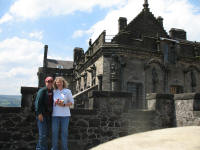 |
As we
left the castle after over five hours of wandering and learning, we
stopped to take a picture of the Wallace Monument in the background behind
Bob and K&K. We will visit it tomorrow. |
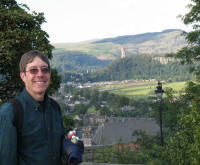 |
|
From the top of the Castle, we
looked over the Holy Rude Kirk Yard. This grave yard dates back to the
16th century and was last used in the 1850's. The people were buried
facing east with all the gravestones in rows. The oldest stone is from
1579 for a stonemasion named Gibb. Some of the stones have pitmarks from
musket shots that were used when the castle was under siege. The skull and
cross-bones and a winged hourglass both symbolize the flight of time.
|
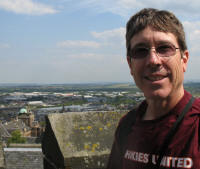 |
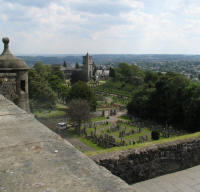 |
 |
|
Kini and Kimi also
got to take a walk about to read the headstones.
|
|
 |
Rein of Alexander III
(1249-1286) Army of King Haakon of Norway wanted to conquer the Scots.
landed at the Coast of Largs a surprise attack on the sleeping Scottish.
To be quiet, King Haakon's army took off their shoes. One of the soldiers
stepped on a thistle and yelled out in pain. This woke the Clansmen who
ultimately won the battle.
Ref.
The Scottish people
joke that if it hadn't been for this spiky little weed, they might have
been speaking Norwegian. |
|
Church of Holy Rude
Holy Rude means "holy cross" and this
church is the second oldest building (the castle itself is the oldest). It
dates to 1129. In 1405, the church burned but was completely rebuilt in
ten years using contemporary gothic arches, stained glass windows, and the
oak roof.
As Reformation was taking place
throughout Scotland, this was one of the first churches to experience the
change over. Indeed, this church actually had a wall built through its
center for a period of time to divide the two congregations and ministers.
James VI was crowned here in 1567 with John Knox preaching. Westminster
Abbey in England is the only other church to have held a United Kingdom
coronation. |
|
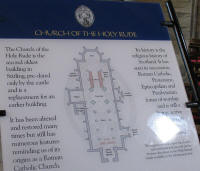 |
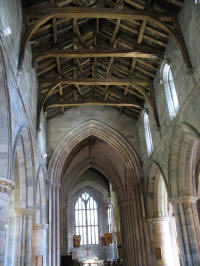 |
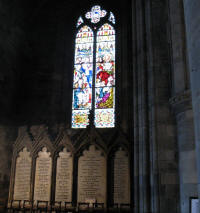 |
|
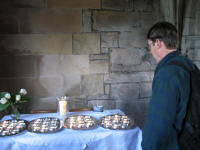 |
As per tradition
when we travel, we lit a candle for all of those that have gone before us. |
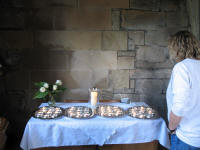 |
| |
|
|
|
 top
top
 |
| |
|
|
|
Day 3 in
Stirling - Monuments & Bridges |
|
Sir William Wallace
Memorial
(Ref.
1 ||
Ref. 2 for Wallace and Bridge) |
|
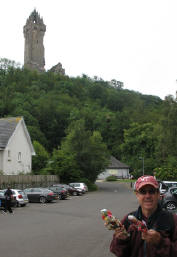 |
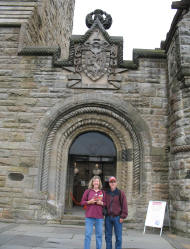 |
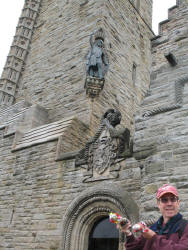 |
|
The cornerstone of this relatively new
monument was laid on June 24th, 1861 on top of Abbey Craig and drew
thousands of people from across Scotland. "The monument is 220 feet high, 54 square feet at its base, with the tower
36 square feet. The walls are 16/18 feet at their thickest, tapering to 5
feet thick at their thinnest. It is estimated that there were in excess of
30,000 tons of stones used in the construction."
Sir Walter Scott was a great
force at this time writing books about Scotland's history and renewing
interest in the battles and people of the past. It was at this time that
he rediscovered the "Honours of Scotland" (crown, sword and sceptre, 1818)
in Edinburgh Castle. They had been locked away and "lost" for the past 111
years.
|
 |
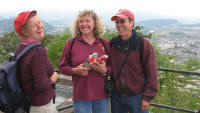 |
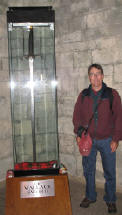 |
We met a delightful Norwegian who was
taken with Kini and Kimi. As we climbed the 246 steps through tiny, stone
spiral stair steps to the top, we stopped at the different displays at
each level. Bob and K&K are standing by the Wallace Sword - think about
wielding that in battle!
By the way, did we mention that William Wallace's life was told in the
movie Braveheart with Mel Gibson? |
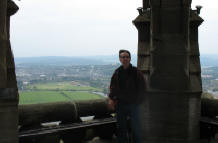 |
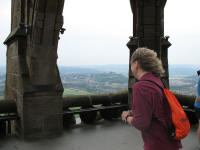 |
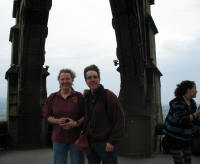 |
|
Although Bob was able to walk to the
edge of the top platform, Amy was glued to the center and being buffeted
by the high winds. She called it "her wimp circle" - "I made it up the 246
steps .... Next I'll have to go down! ... Is there a potty up
here?!"
The view overlooks the river Forth
and the Forth Valley. The river Forth (named because of the glacier Fourth
that carved it out in ancient times) empties into the firth (a channel)
that ultimately leads to the North Sea. Just outside of these pictures is
the firth of Fourth. |

A spectacular view of the castle!
|
Sir William Wallace: A Very
Condensed Biography
(Ref.
1 ||
Ref. 2 for Wallace and Bridge) |
Sir William Wallace was one of the
leaders and heros of the Scottish Wars of Independence (from England). At
the Battle of Stirling Bridge in 1297, Sir William Wallace defeated the
English army of invaders. Then in 1298, Wallace's forces were defeated at
the Battle of Falkirk. Toward the end of the the wars, the Scottish
started to use a scorch and burn, hit and run policy as fought. In 1305,
after Wallace had gone to France to ask for help for the Scottish people
and their supported king, he returned to Scotland and was captured and handed over to
King Edward I of England.
"Wallace was transported to London
and taken to Westminster Hall, where he was tried for treason and was
crowned with a garland of oak to suggest he was the king of outlaws. He
responded to the treason charge, "I could not be a traitor to Edward, for
I was never his subject." With this, Wallace asserted that the absent John
Balliol was officially his king."
"Following the trial, on 23 August
1305, Wallace was taken from the hall, stripped naked and dragged through
the city at the heels of a horse to the Elms at Smithfield. He was hanged,
drawn and quartered — strangled by hanging but released while he was still
alive, castrated, eviscerated and his bowels burnt before him, beheaded,
then cut into four parts. His preserved head (dipped in tar) was placed on
a pike atop London BridgeIt was later joined by the heads of the brothers,
John and Simon Fraser. His limbs were displayed, separately, in Newcastle
upon Tyne, Berwick-upon-Tweed, Stirling, and Aberdeen." |
|
|
The Battle of Stirling Bridge: |
The year was 1297 and Scotland was
fighting for its freedom from English rule. England had been winning
battles for some time. Wallace and his men were camped on the Abbey Craig
(where the monument now stands). The English army was approaching from the
direction of the castle with a superior force. They ask for surrender but
the Scots decline.
The stage is set for a momentous battle. |
 |
We have turned the map from the
internet (Ref.)
upside down to match the orientation of our photo. Click on our photo and
follow the river to find the 15th century stone bridge located
within yards of the earlier Stirling bridge.
(The photos below show the stone bridge.)
In 1297, the wooden bridge allowed two
horses with riders to cross side-by-side. The English army was feeling
very confident, to the point that when the riders started to cross at
dawn, they were called back by their leader, Warenne, who had overslept
and wanted to lead his warriors. So, they start across again. And again
Warenne calls them back thinking that Scots would understand how badly
they were outnumbered and finally negotiate.
It was not William Wallace's way.
He let the English know that there would be a battle this day.
|
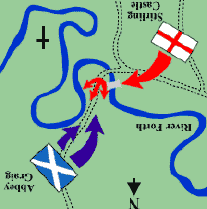 |
|
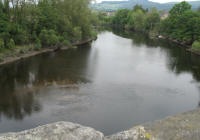
Where the original bridge stood |
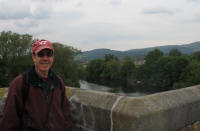
On the current bridge |
|
Warenne doesn't listen to his advisor
who wanted to send some men up the river to be able to flank the Scots. If
he had, there may have been a very different ending to this battle and to
Scottish history. Instead, Warenne starts his men moving across the wooden
bridge. This would take several hours because of the small size of the
bridge.
And Wallace was there. He lets about
half the men cross the bridge - the number he felt that he could take and
win. The Scots rushed down with the love of a free Scotland in their
hearts. The English are trapped on a little piece of land with mucky river
banks and deep waters on all sides. Wallace and his men cut down over 100
men-at-arms and 5,000 infantry - a few that are able to fight their way
back to the river, ditch their heavy armament and are able to swim to
safety.
|
|
Ref. |
|
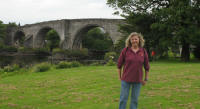 |
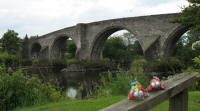 |
 |
|
We all took turns getting our pictures
taken in front of the "new 15th century" old bridge. |
|
|
|


